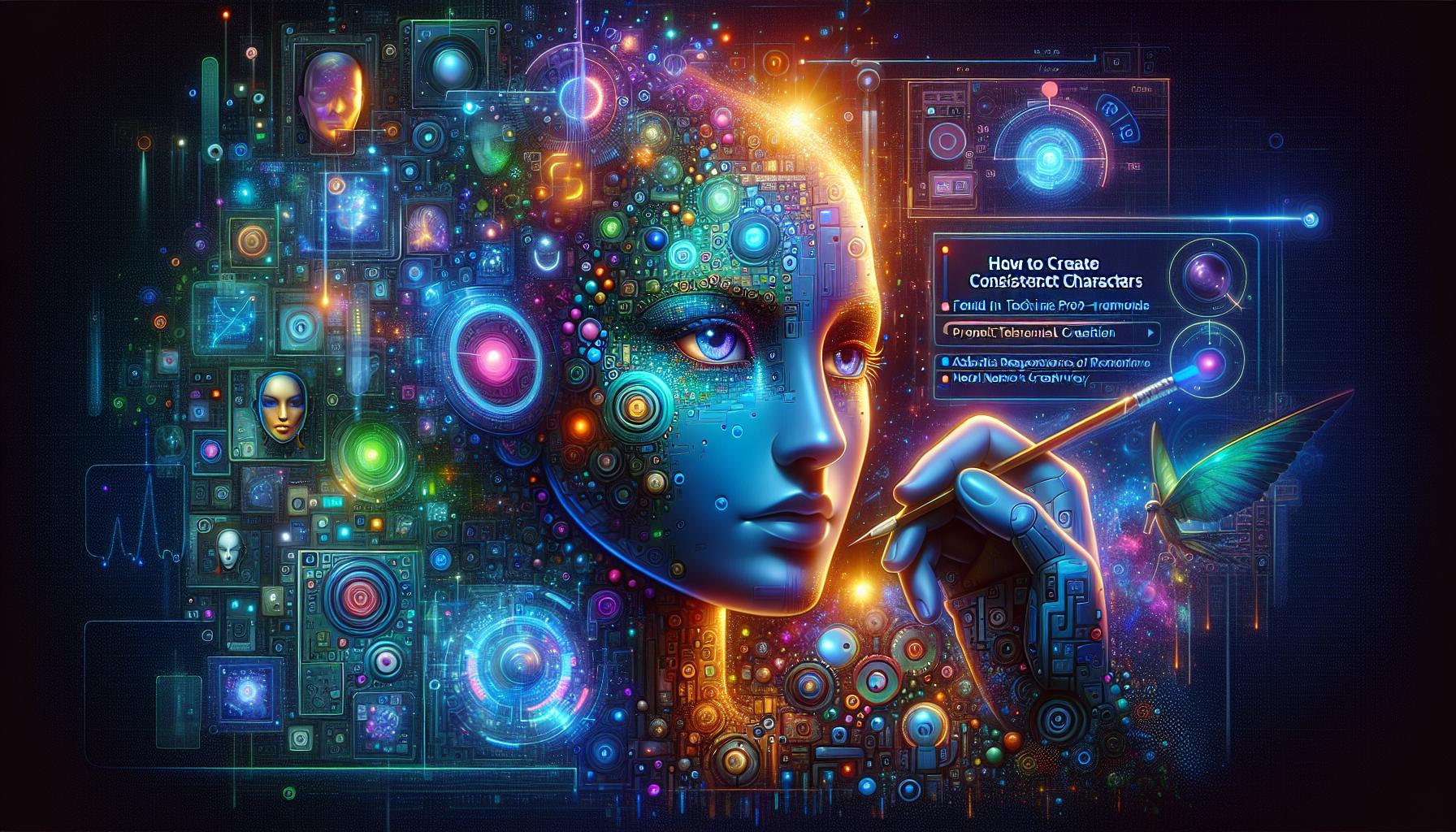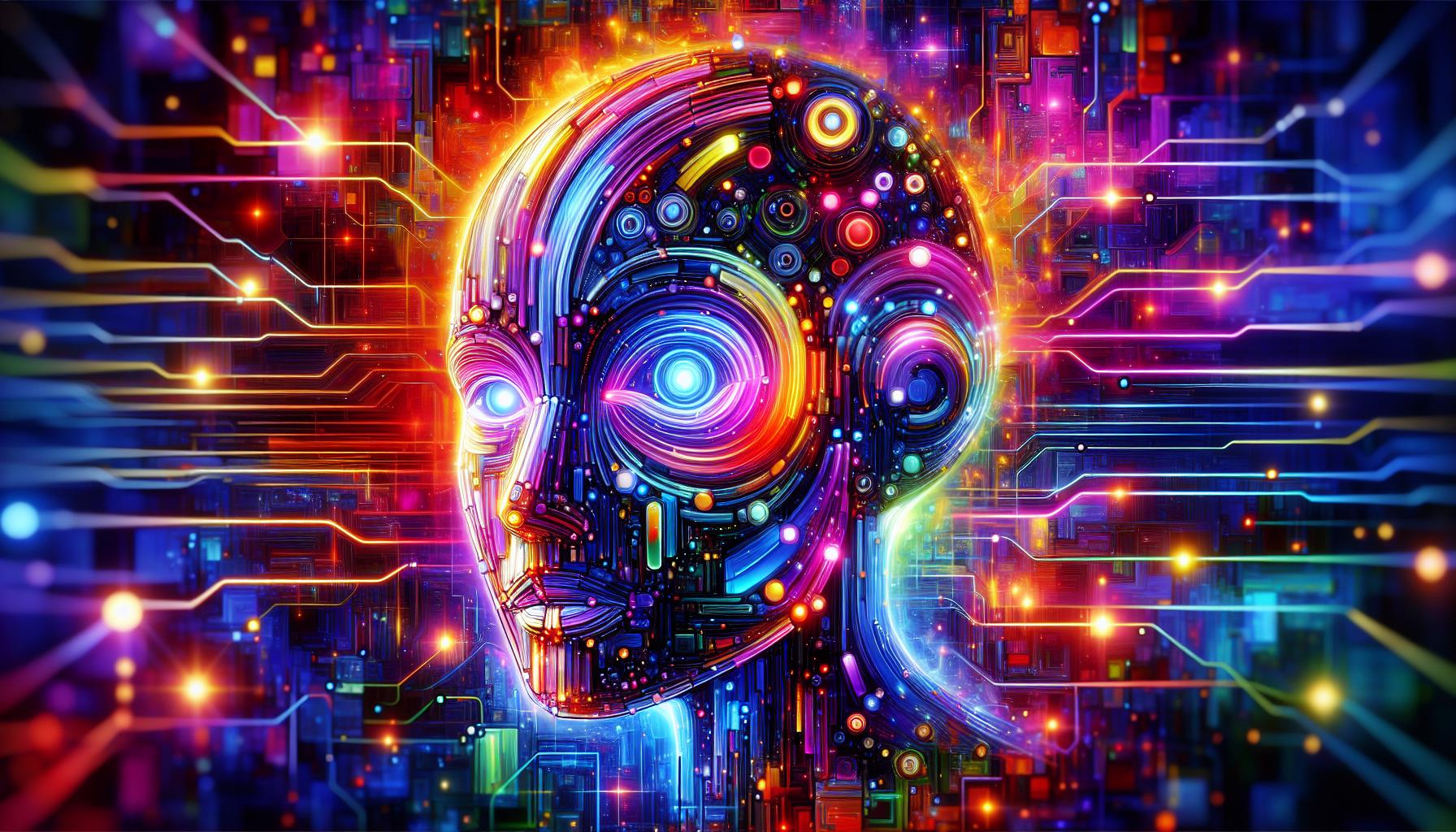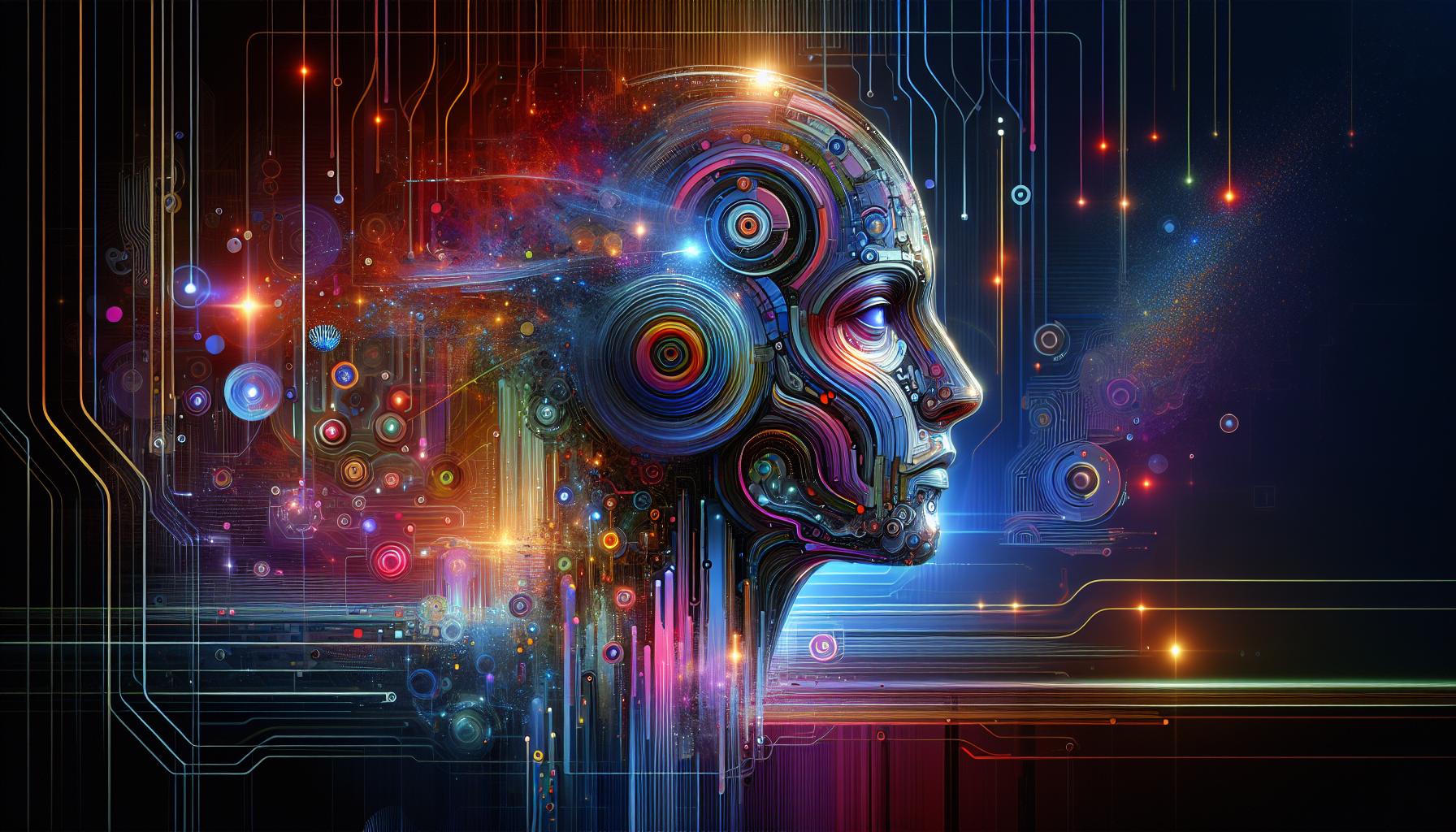Creating unique and consistent characters in digital art can be a challenging task, particularly when using AI tools like DALL-E 3. Understanding how to maintain a cohesive appearance while exploring diverse scenarios is essential for building engaging narratives. This guide unveils expert techniques to help you master character consistency, enhancing your storytelling potential.
Understanding DALL-E 3: The Basics of AI Image Generation
DALL-E 3 represents a major leap in AI image generation, offering users the ability to craft highly detailed images simply from text descriptions. This model enhances the interpretation of complex prompts, making it possible for creators to generate images that encapsulate their ideas with remarkable accuracy. At its core, DALL-E 3 combines advanced natural language understanding with sophisticated image rendering capabilities, allowing it to comprehend and visualize concepts in a way that previous models could not.
One of the standout features of DALL-E 3 is its support for producing text within images seamlessly. Whether you’re designing promotional material or creating educational content, the model can incorporate sharp, readable text in various formats-perfect for captions and posters. This enhancement not only increases the model’s functionality but also elevates the user experience by fulfilling diverse creative needs.
When experimenting with DALL-E 3, users should embrace its flexibility regarding aspect ratios. The model accommodates horizontal, square, and vertical outputs, providing adaptable solutions for different projects. This versatility means that whether you’re creating a banner or a profile picture, you can tailor the output to meet the specific requirements of your design.
To truly harness the potential of DALL-E 3, it’s essential to master the nuances of prompt crafting. Here are a few tips to ensure consistency when generating characters:
- Define Character Traits: Clearly outline physical attributes, clothing styles, and emotional expressions.
- Use Descriptive Language: Incorporate adjectives and specific details to enhance character uniqueness.
- Set Context: Use scenario-based prompts to position your characters in environments that reflect their personalities.
By employing these strategies, creators can achieve greater coherence across images, tying together various iterations of characters and establishing a recognizable brand or narrative identity. This approach not only enhances storytelling but also enriches the overall viewing experience, making the most of DALL-E 3’s sophisticated image generation capabilities.
Crafting Character Profiles: Why Consistency Matters
To create truly memorable characters, especially when utilizing platforms like DALL-E 3, maintaining consistency is essential. In the realm of digital art and storytelling, characters must resonate with the audience, evoking emotions and building a connection. Consistent character profiles not only enhance visual storytelling but also ensure that viewers can easily identify and engage with the personas crafted. Mixing up traits or styles can confuse the audience and dilute the impact of your narrative, making it vital to adhere to defined attributes throughout your creative process.
Key Elements to Maintain Consistency
When developing character profiles, several elements must be carefully considered to ensure uniformity across different illustrations or depictions:
- Visual Traits: Color schemes, distinctive clothing, physical features, and recognizable accessories should remain consistent. For instance, if a character wears a blue cloak, switching it to green in another depiction can lead to viewer confusion.
- Character Traits: Core personality traits, such as being adventurous or timid, should remain apparent in every portrayal, ensuring that audiences recognize the character’s essence regardless of the situation depicted.
- Environment Context: The environments that characters interact with can affect their portrayal. Consistently placing them in familiar settings helps reinforce their identity.
By utilizing tools like DALL-E 3 effectively, artists can generate unique images that retain the same character qualities across various scenarios. The use of specific descriptors and previously generated identifiers (Gen IDs) allows artists to modify existing characters while preserving their distinctive traits, immensely aiding in crafting a cohesive visual narrative.
Incorporating these strategies can transform your character creation process into a coherent exercise, ultimately yielding results that resonate more deeply with your audience. For example, when a wizard is consistently portrayed with a specific color palette and recognizable magical artifacts, new images can extend his story with a sense of familiarity that allows the audience to feel more invested. This intentionality lays the groundwork for rich storytelling within your visual compositions, making every illustration not only visually appealing but contextually relevant.
Overall, understanding how to create consistent characters in DALL-E 3 not only enhances artistic outputs but also elevates the overall impact of visual storytelling in a crowded digital landscape.
Key Techniques for Maintaining Character Traits Across Images
Creating a series of images with consistent character traits can transform a simple visual experience into a captivating narrative. To achieve this consistency in DALL-E 3, it is essential to establish clear and detailed prompts that encapsulate the essence of your characters. This not only helps in maintaining their look but also in preserving their personality, ensuring that each representation feels cohesive and true to the original concept.
Define Core Traits and Descriptors
When entering your prompts, begin by outlining the core traits of your character. These traits can include physical attributes, clothing styles, and emotional states. To facilitate this, consider creating a character profile that lists specific details such as:
- Physical Appearance: Hair color, eye color, and build.
- Clothing: Style, colors, and accessories.
- Personality: Cheerful, mysterious, or adventurous.
For example, if your character is a cheerful young woman with curly blonde hair and a love for vintage clothing, structure your prompts to consistently emphasize these features. “Generate an image of a cheerful young woman with curly blonde hair, wearing a vintage floral dress, standing in a sunlit park.” This methodical approach leads to a clearer visual representation across various images.
Utilize Reference Images and Mood Boards
Having a collection of reference images or a mood board can dramatically improve the consistency of character traits across images. These references should include not only pictures of the character but also images depicting their environment and relevant objects associated with them. You can incorporate these references into DALL-E’s generation process by including phrases like, “In the style of the provided images,” or simply referencing items and settings that are important to the character’s identity.
For example, if your character frequently interacts with nature, the prompt could be expanded: “Generate an image of a cheerful young woman with curly blonde hair in a vintage floral dress, holding a wicker basket, surrounded by blooming wildflowers.” By enhancing the contextual richness of each prompt, the AI is better equipped to capture the character’s essence in varied scenarios.
Iterative Refinement
The creation process is inherently iterative. Experiment with your prompts and iteratively refine them based on the results. After generating images, assess them critically to identify which traits are successfully captured and which need more emphasis or adjustment. For instance, if the expression was not as joyful as intended, update your next prompt to include more emotive language: “Create an image of a cheerful young woman with curly blonde hair in a vintage floral dress, smiling widely as she gathers flowers.”
This process of evaluation and modification not only enhances the consistency of character portrayals but also allows for greater creativity in exploring different contexts or scenarios without losing the foundational traits that define your character.
Through these techniques, you can effectively create a cohesive visual narrative that showcases character growth and maintains clarity in identity, aligning well with the core principles laid out in the guide on how to create consistent characters in DALL-E 3.
Utilizing Prompts Effectively: Creating a Recognizable Style
Creating memorable and engaging characters in DALL-E 3 hinges on the thoughtful use of prompts. The right prompts not only dictate the visual outcome but also establish a consistent style that can become a signature look for your creations. By crafting a recognizable aesthetic, you can ensure that your characters resonate with viewers, making them more relatable and engaging.
To start, adopt a problem-solving approach to your prompts. For instance, clearly define the attributes of your character before generating images. Use precise language to convey elements such as age, clothing, facial expressions, and environmental context. Here are some effective strategies:
- Consistency in Descriptions: Employ similar terminology for character attributes across different prompts. If your character has “bright green hair,” maintain that description instead of switching to “luminous green” in later prompts.
- Establish Backstory Elements: Provide backstory details that can influence the visuals. For example, a character who is an adventurous treasure hunter might wear rugged attire and carry tools that reflect their profession.
- Emotionally Charged Prompts: Consider the emotions your character should evoke. Descriptions that include specific emotions can guide the visual tone of the imagery, such as “a joyful expression while exploring a lush jungle.”
In practice, you could develop a character called “Elena, the Time Traveler.” A full prompt might look like this: “Create an image of Elena, a young woman with bright green hair and a vintage leather jacket, joyfully exploring a futuristic city filled with neon lights.” Using such detailed prompts not only clarifies your vision but also enhances consistency across multiple creations.
Finally, keep refining your prompts by reviewing the generated images. Analyze what elements work well and what might need adjustment. This iterative feedback loop not only enhances the visual output but also sharpens your skills in crafting more effective prompts, crucial for mastering the art of character consistency in DALL-E 3. By implementing these strategies, you’ll be well on your way to establishing a distinctive and cohesive character style that stands out.
Mastering Visual Details: Colors, Textures, and Expressions
To truly bring characters to life in DALL-E 3, mastering the visual details such as colors, textures, and expressions is paramount. The subtleties of color can convey emotions and traits that define a character’s personality. For instance, a vibrant palette with yellows and reds might illustrate a joyful character, while muted blues and grays can express sadness or introspection. Understanding the psychological impact of colors allows creators to strategically choose hues that resonate with their intended message.
When it comes to textures, incorporating them into your character designs can elevate the realism and depth of the visuals. Details such as the sheen of fabric, the roughness of skin, or the softness of hair can create a more convincing representation. In DALL-E 3, you can specify the texture by using descriptive language in your prompts. Words like “silky,” “gritty,” or “fuzzy” can guide the model in rendering your character with the appropriate tactile qualities. Adding these elements in your design will help communicate the character’s background and personality more effectively.
Moreover, the expression on a character’s face can tell a story that words alone cannot. Whether it’s a sly grin or a look of intense concentration, the subtleties of facial expressions play a critical role in character development. To capture these nuances in DALL-E 3, be explicit in your prompts about the emotion you wish to convey. Using terms such as “wide-eyed wonder” or “subtle frown” directs the AI to focus on those details, enhancing the character’s narrative with visual cues that viewers can intuitively understand.
Incorporating these elements systematically can significantly improve how you create consistent characters in DALL-E 3. By focusing on colors, textures, and expressions, you can gain a deeper understanding of your character’s identity, enhancing the overall storytelling power of your visuals. Consider practicing with different combinations and noting the transformational effects each detail can impart to your character designs to refine your technique further.
Key Elements to Focus On
- Color Selection: Choose colors based on the emotional resonance they create.
- Texture Description: Use vivid language to describe textures that enhance realism.
- Facial Expressions: Be specific about emotions in your prompts for clearer character storytelling.
Iterative Refinement: Enhancing Consistency with Feedback
In the realm of character design using AI tools like DALL-E 3, the journey does not end with the initial creation of an image. Instead, it is through a process known as iterative refinement that creators can enhance their characters’ consistency, making them relatable and visually cohesive. Feedback plays a pivotal role in this process, acting as a crucial bridge between the initial draft and the final version that resonates with the intended audience.
Embracing Feedback for Continuous Improvement
When developing characters in DALL-E 3, seeking feedback from diverse perspectives is invaluable. Engaging with fellow creators, artists, or even potential audience members allows for a multifaceted view of the character’s appeal and resonance. Here are some effective approaches to gather and utilize feedback:
- Feedback Groups: Establishing a focus group of peers can lead to enlightening discussions that help identify strengths and weaknesses in character designs.
- Online Communities: Platforms like Reddit, Discord, or specialized forums can provide instant feedback from fellow creators who understand the intricacies of DALL-E 3.
- Surveys and Polls: Creating surveys can yield quantitative data about character attributes, enabling you to pinpoint elements that might need adjustments.
After collecting feedback, it’s essential to analyze and prioritize the insights received. Not all feedback will be actionable or fit your vision, so consider adopting the following strategies:
Prioritizing Feedback
Utilizing a structured approach will aid in sifting through suggestions effectively. Here’s how to categorize and prioritize feedback for your characters:
| Feedback Type | Action Required | Impact on Consistency |
|---|---|---|
| Visual Elements | Revise color schemes or features | High |
| Emotional Resonance | Adjust character expressions | Medium |
| Background Story | Enhance backstory for clarity | Medium |
| Interaction with Environment | Modify poses or settings | High |
By categorizing feedback into these areas, you can focus your iterative refinement efforts more strategically. For instance, if visual elements are the most frequently noted areas for improvement, prioritizing these changes can significantly enhance the overall consistency of your character across various scenarios created in DALL-E 3. Ultimately, this ongoing process fosters a richer, more engaging character identity that captivates your audience and serves your creative vision.
Real-world Examples: Successful Character Creation in DALL-E 3
Creating characters that resonate and maintain consistency in art can be challenging, but with DALL-E 3, this task is significantly simplified. The advancements in this AI technology allow users to depict characters that are not only vivid but also coherent across various scenarios. Real-world applications of DALL-E 3, especially in character creation, showcase its unique strengths and versatility, making it a powerful tool for artists, marketers, and storytellers alike.
One compelling example comes from the gaming industry, where developers leverage DALL-E 3 to generate character assets that evolve alongside their narratives. By defining specific attributes such as facial expressions, outfits, and background story elements, teams have been able to maintain character consistency while experimenting with different visual styles and settings. For instance, a character intended to portray a brave knight might be illustrated under various conditions-such as battling in a snowy landscape or conversing in a bustling tavern-without losing their core identity.
In the realm of children’s literature, illustrators can utilize DALL-E 3 to create a memorable cast of characters. By providing detailed prompts that include key descriptors like color schemes, personality traits, and key objects associated with each character, authors can generate images that clearly communicate their story’s essence. For example, a whimsical fox could be depicted donning a tiny top hat and monocle, ensuring that he remains instantly recognizable, regardless of the scene. Such clarity facilitates a cohesive visual experience for readers, enhancing their connection to the story.
To ensure success when using DALL-E 3 for character creation, consider the following practical strategies:
- Consistency in Descriptions: Use the same language and descriptors across multiple prompts to build a reliable character profile.
- Iterative Refinement: Generate multiple images, selecting those that best capture the desired essence. Adjust your prompts based on the results.
- Dynamic Contextualization: Experiment with placing characters in various scenarios to explore their reactions and development while retaining core attributes.
These methods not only highlight how to create consistent characters in DALL-E 3 but also serve as a framework for producing rich, engaging visuals that contribute to storytelling or brand identity. By understanding and applying these pro techniques, users can harness the full potential of this innovative tool.
Troubleshooting Common Challenges in Character Consistency
When working with DALL-E 3, achieving character consistency can sometimes feel like juggling multiple tasks at once, especially when your artistic vision requires your characters to convey depth and emotion across various illustrations. Without careful attention, elements such as physical traits, clothing styles, or even personality threads can drift apart, leading to a disjointed experience for the audience. Luckily, implementing some practical strategies can streamline the process of maintaining character consistency amidst these challenges.
Identify and Document Character Traits
A surefire way to avoid inconsistency is to establish a comprehensive character profile. Begin by documenting essential features such as:
- Name: Choosing a name that resonates with your character’s background enhances relatability.
- Appearance: Write down details about hair color, eye shape, and notable features.
- Clothing Style: Specify the character’s usual attire, including color palettes and accessories.
- Personality Traits: Note key personality aspects that inform their actions and reactions.
Creating a character sheet can be a valuable reference, allowing you to visualize their development over time and ensure that every output remains true to their identity.
Utilize Consistent Prompts and References
When designing a new piece with DALL-E 3, consistency starts with your prompts. Keep core elements of the character description intact across different prompts. Here are some tips on how to enhance your prompts:
- Use the same adjectives and nouns related to the character in each prompt, ensuring clarity and focus.
- Incorporate a visual reference if possible. Reference images or previous DALL-E 3 creations can help reinforce similarities.
- Be specific about settings and interactions within scenes that reinforce the character’s personality and traits.
Consistency in your approach not only ensures coherence but also helps DALL-E 3 learn and adapt to the nuances of your character over time.
Review and Iterate
No first draft is perfect. After generating your images, take the time to review each piece critically. Compare generated images with your established character traits and identify areas of inconsistency. Keep a checklist of critical elements to verify against your character profile:
| Element | Status | Notes |
|---|---|---|
| Appearance | Consistent/Needs Work | |
| Clothing | Consistent/Needs Work | |
| Personality | Consistent/Needs Work | |
| Pose/Expression | Consistent/Needs Work |
By checking off these elements, you can pinpoint where adjustments are necessary, allowing for nuanced edits that align your artwork more closely with your character’s identity. Revisions become an extension of your creative process rather than an afterthought, ultimately refining the consistency of your character as seen in “How to Create Consistent Characters in DALL-E 3: Pro Techniques.”
Q&A
How to Create Consistent Characters in DALL-E 3: Pro Techniques?
To create consistent characters in DALL-E 3, focus on using detailed, consistent prompts that describe appearance, clothing, and personality traits. Maintain similar styles and angles across images to enhance coherence.
Being specific is crucial; describe attributes like eye color, hairstyle, and clothing patterns. For example, instead of saying “a dog,” specify “a golden retriever wearing a red scarf.” This approach ensures DALL-E 3 generates characters that feel unified across multiple images. For more tips, check our guide on character design in DALL-E 3.
What is the importance of consistency in character design?
Consistency in character design is essential for storytelling and audience recognition. It helps create a strong visual narrative and builds familiarity.
When characters look and feel consistent, audiences can easily connect with them. This principle is vital in media like animation and games, where characters evolve over time. Employing consistent attributes helps DALL-E 3 create an engaging and recognizable character.
Can I adjust character details in DALL-E 3 after generation?
No, once an image is generated in DALL-E 3, you cannot modify it directly. However, you can refine your prompt and regenerate to create a better fit.
If your initial attempt doesn’t meet your vision, try adjusting descriptive elements in your prompt. For example, include more specific phrases about the character’s setting to reshape the results. This iterative approach allows for gradual refinement of your character designs.
Why does DALL-E 3 sometimes create inconsistent characters?
DALL-E 3 may produce inconsistent characters due to vague or overly broad prompts. If the instructions are not detailed enough, the AI can misinterpret your vision.
To achieve better consistency, always use detailed and specific descriptions couched in a strong narrative context. This ensures DALL-E 3 understands the character’s essential features and relationships to other elements in the image.
How can I improve my prompts for DALL-E 3?
You can enhance your prompts for DALL-E 3 by adding more contextual details and focusing on key visual characteristics. This clarity leads to better results.
Consider including aspects like mood, age, and environmental context when formulating your prompts. For instance, instead of saying “a cat,” you might say “an adventurous tabby cat exploring a sunny garden.” This approach can significantly improve output quality and character consistency.
What techniques can help with character personality and emotion in DALL-E 3?
To imbue character personality and emotion in DALL-E 3, include adjectives and descriptive phrases that convey mood and behavior, as part of your prompts.
For example, instead of a neutral description, you could state “a cheerful young girl with bright eyes and a playful smile.” Such details help DALL-E 3 capture not just the visual but also the emotional essence of your character, making them more relatable.
How does using reference images impact character design consistency?
Using reference images can significantly enhance the consistency of character designs in DALL-E 3. They provide visual benchmarks that guide the generation process.
When you upload or refer to a specific character or style, DALL-E 3 can better align with the visual traits you want. This technique helps bridge gaps in understanding and solidifies your character’s identity across various scenes.
Wrapping Up
In conclusion, creating consistent characters in DALL-E 3 requires a blend of strategic prompting and an understanding of the model’s capabilities. By utilizing detailed descriptions that encompass personality traits, visual elements, and context, you can effectively guide the AI to produce images that reflect your vision. Remember to experiment with variations in your prompts, as this can yield unique and refined results that enhance character consistency.
As you continue to explore the possibilities with DALL-E 3, don’t hesitate to dive deeper into its features and functionalities. Consider documenting your creative journey and sharing insights, as this not only builds your skills but also contributes to the broader community of AI enthusiasts. Embrace your creativity and take the leap-DALL-E 3 is a powerful tool that can transform your ideas into striking visual narratives. Happy creating!





